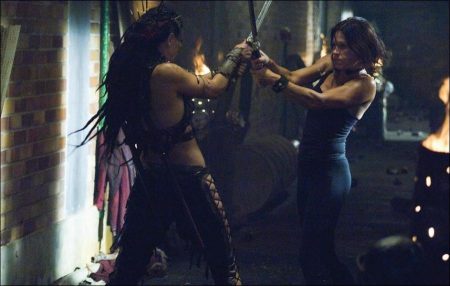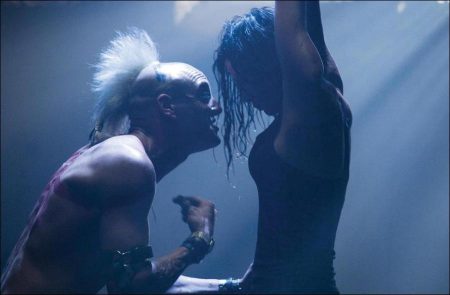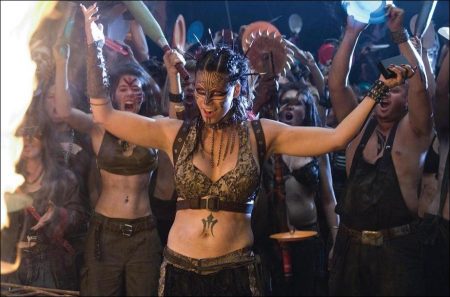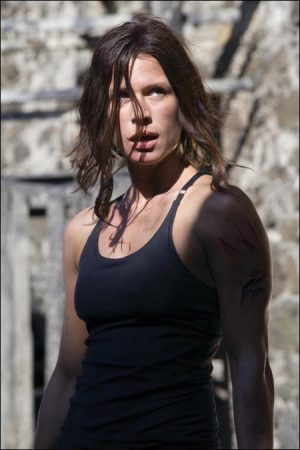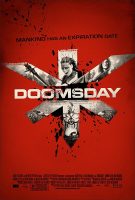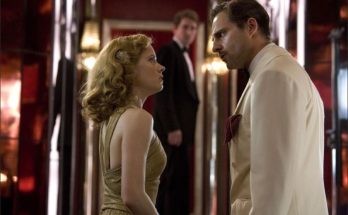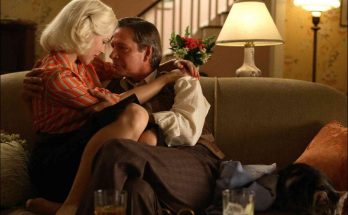Tagline: The end is high.
Mankind now has an expiration date. The year is 2008, but that number matters little, as a pandemic threatens to wipe out the whole of the human race. For many in the United Kingdom—the epicenter of the outbreak—the end is nigh, so why bother to keep count?
Within days of detection of the Reaper virus—replete with open skin sores, uncontrollable bleeding and, ultimately, fatal liquefaction of internal organs— millions are infected in Scotland, the killer disease’s home turf. Government has no choice but to declare the country a “hot zone” and quarantine the populace in hopes of containing the Reaper’s spread.
With military blockades on every highway, bridge and railway, all traffic in or out is halted, and a 21st-century version of Hadrian’s Wall is erected around Scotland’s border. Sealed off from the rest of the world, what was once Scotland is now a forgotten No Man’s Land, with the Reaper given free reign to annihilate the population sealed inside.
A quarter of a century later, with a new outbreak of the Reaper resurfacing in an overcrowded London, it becomes apparent that the government’s best laid plans have gone completely, bloody awry. Department of Domestic Security (DDS) Chief Bill Nelson (Bob Hoskins) is summoned to meet with the prime minister (Alexader Siddig) and the true power behind his office, Michael Canaris (David O’Hara), who reveal satellite photos of Reaper survivors in the hot zone. And survivors must mean there’s a cure…
Nelson quickly assembles a crack team of specialists to venture into the forsaken land and retrieve the counteragent to the virus, once the pet project of the now presumably dead Dr. Kane (Malcolm McDowell). For the tough and efficient commanding officer, Major Eden Sinclair (Rhona Mitra), the assignment represents a disquieting homecoming. Twenty-five years earlier, in the final moments of containment, she had been shoved into one of the last evacuating military choppers and flown to safety…forced to leave her mother behind.
Once on the other side of the immediately resecured border, the squadron— which also includes Sergeant Norton (Adrian Lester)—is on its own, venturing into a ghoulish terrain of corpse-strewn, forlorn cities. All too soon, however, the crew meets up with a pack of feral survivors, and finds itself unwittingly standing in for the callous government that turned its back years before. Caught between two bloodthirsty factions of the Reaper’s legacy, Sinclair and her decimated squad fight to remain alive while racing to retrieve the cure…before the reborn virus ushers in the dawning of a new dark age.
Doomsday is a 2008 science fiction action horror film written and directed by Neil Marshall. The film takes place in the future in Scotland, which has been quarantined because of a deadly virus. When the virus is found in London, political leaders send a team led by Major Eden Sinclair (Rhona Mitra) to Scotland to find a possible cure. Sinclair’s team runs into two types of survivors: marauders and medieval knights. Doomsday was conceived by Marshall based on the idea of futuristic soldiers facing medieval knights. In producing the film, he drew inspiration from various movies, including Mad Max, Escape from New York and 28 Days Later.
For its theatrical run, the film was originally intended to be distributed by Focus Features under Rogue Pictures, but the company transferred Doomsday among other films to Universal Pictures for larger-scale distribution and marketing beginning in 2008. Doomsday was commercially released on 14 March 2008 in the United States and Canada in 1,936 theatres, grossing US$4,926,565 in its opening weekend and ranking seventh in the box office, which Box Office Mojo reported as a “failed” opening.
About The Production
DOOMSDAY sees the acclaimed, on-the-rise director working on his biggest canvas to date, following the success of his two well-received films, Dog Soldiers and The Descent. For Neil Marshall—who, in his native U.K., is referred to as one of the “Splat Pack”—this meant splashing the screen with a combination of nonstop action and in-your-face thrills, set in a near futuristic and fully nightmarish landscape. But going against current action-thriller custom, with its heavy reliance on flashy effects born out of CGI, he was intent on creating the type of film he grew up on, one rarely seen in the multiplexes nowadays.
He opens, “One of the things I was adamant about doing with DOOMSDAY was going back to a kind of gritty stunt/action movie that doesn’t get made anymore: real people, in a real world, doing really dangerous stuff! No green screen, no wires, just crazy ‘stunties’ standing on, jumping into and hanging out of cars traveling at 80 mph and smashing into each other.
“In that way, DOOMSDAY is my vision of the future,” continues Marshall. “A deadly virus attacks the U.K. and the government is forced to build a wall to quarantine the whole of Scotland in order to ensure the survival of the rest of the nation. The story picks up 25 years in the future, when an elite team is sent in, over the wall, to try to find a cure for the Reaper virus.”
For producer Benedict Carver—president of Crystal Sky Pictures, which is headed by fellow producer Steven Paul—Marshall’s evolution from helming a small budget to a somewhat bigger budget was natural and expected. “Dog Soldiers was quite a good, economical film,” Carver offers. “So was The Descent, and Neil wrote and directed both. If you’re a good director, you can direct a film at any budget. And, to my mind, he showed real ability with both of those films that could translate to DOOMSDAY.”
While this film may glance over its shoulder at some of the outstanding genre films of the 1970s and early ’80s, it is definitely a current-day creation of the inventive storyteller who conjured Scottish soldiers being picked off by werewolves and strong women trapped in caves with bloodthirsty predators.
Producer Paul comments: “Neil’s latest is inspired by the postapocalyptic films of the past, like Escape From New York, The Warriors, The Omega Man and Mad Max. Those are the films that have inspired Neil and us to make this movie. We wanted to do something reminiscent of the films of John Carpenter and George Miller, and all those great genre directors of the ’70s. Although we’re sort of paying homage to those kinds of films, Neil completely brings his own original mix to DOOMSDAY.”
Originally, the idea for the film came to the director as he imagined a scenario in which an ultramodern action warrior is confronted by a knight in armor…in a postapocalyptic landscape. Observes Marshall, “I think it’s a genre that hasn’t been tackled for awhile, and it harkens back to the films that I love.”
All acknowledged that creating such a vision in this postmodern way would present its own set of challenges. Per Carver: “We knew this was going to be a very difficult project to put together, basically because it’s a big action film that we were going to make for a modest budget. And Neil wanted to do all of the action in a more physical way, as opposed to relying on a lot of visual effects. So, we had to find somewhere where we could put everything together and shoot it ‘for real,’ as opposed to doing it on a computer.”
And shooting it for real necessitated finding a cast eager to perform it for real…complete with sucker punches, oozing sores, severed heads, sword fights, car chases, cannibal feasts, mob scenes and more.
When Marshall had written the treatment for the film five years earlier, it had centered on the character of Major Eden Sinclair. Describing her, he says: “Sinclair is a hard-nosed soldier, a cold-blooded killer in the near future, who, somewhere along the road, has lost her soul. She is a product of the system in which she grew up, but she has a different history and is connected to the story on a very emotional level. Her mission—to find the cure for the lethal virus—is a journey of redemption and soul-searching. She has to reconnect with her humanity. It’s her homecoming, literally, and she has to find what she lost as a child. Because of the virus, and its disastrous effect on her country, her life has turned out very differently from the plan. She has had to become very independent, because she had no one to look after her. She learned to fight on the streets, and hold her own amongst the guys.”
In his previous films, Marshall has worked with relatively unknown actors, having once declared that he planned, like director John Ford, to work with the same ensemble cast on all his movies. He says, “Ideally, I want to work with a kind of theatrical ensemble on every film, but each time, trying something new, swapping them around and giving them new roles, so that they can have fun with something different. At the same time, I want to add new actors to the mix to keep it fresh.”
The writer / director also notes that, while he keeps his ensemble in mind while penning the screenplay, he does not necessarily write the parts with specific actors already assigned. He remains open to the process…so open, in fact, that to fill his leading role of Sinclair, the filmmaker utilized open auditions.
Into those calls walked Rhona Mitra, an English actress now based in Los Angeles, who has received much attention thanks to her performances in such television hits as The Practice, Boston Legal and Nip/Tuck and the films Shooter and The Number 23.
Director Marshall: “Her audition was great, and when we met her later in London, we realized that we had found Sinclair. Her reading of the character was gritty and tough, but she understood the emotional journey and Sinclair’s connection to her past.”
Mitra immediately recognized something in the character of Sinclair. Mitra observes, “She is disillusioned with the state of her country, and when she is offered this mission to return to where she came from, to try and find the cure for the virus, she grasps the opportunity to go back and find out what really happened. Her journey is incredibly varied, traveling through these diverse visions of history and fashion and culture and madness that is this world Neil has created.”
Mitra continues, “Sinclair doesn’t have a chip on her shoulder, she just sees the world for what it is. She’s not a bimbo and she’s not a ball-breaker, but she is very no-nonsense. I play her as a streetwise London girl, which is what I am. She has to be physically fit, but I also wanted to ensure that I didn’t look like I’d spent 24- hours-a-day in the gym.”
The actress was impressed with Marshall, beginning with their first meeting to discuss the role. She realized that his conviction was palpable, and that he was going the film the script he had written with total support from the studio. The two also discussed the repeated mishandling of the role of the female action hero onscreen, and both found a couple of stellar exceptions to the rule: Linda Hamilton in The Terminator and Sigourney Weaver in the Alien series. (While Mitra found inspiration in those women during filming, she was also influenced by two men: “I definitely occasionally felt Mel Gibson or Harrison Ford sitting on my shoulder in some scenes!”)
In addition to the obvious action-thriller-adventure elements, Mitra found resonance in the themes of ecological fragility and political duplicity that affect our world today. She reflects, “Unfortunately, we’re facing those same things now.” And while Mitra would be joined by actors from Marshall’s previous films— including Sean Pertwee, Craig Conway, Myanna Buring and Darren Morfitt—the director was anxious to work with other actors of the stature and experience of Bob Hoskins and Malcolm McDowell. “Bob and Malcolm both bring vast experience,” he commends, “and it has been a real pleasure to work with them. They know what they are doing, and they get on with the job.”
According to the veteran McDowell, it was the genre of DOOMSDAY—or the amalgam of genres—along with Marshall, that figured heavily in his signing on. He muses, “I’m not sure what genre it is, actually. What’s nice about it is that it’s not a horror film, it’s not a sci-fi kind of film, but it’s a mixture of a lot…say, an adventure film with sort of sci-fi and horror elements. It’s hard to pigeonhole it. And that’s its strength, not its weakness. It’s a tremendous script, and Neil has a tremendous track record.”
Too, it didn’t hurt that the role of Kane was a plum one. McDowell continues, “Kane’s this large character—he’s the leader of the surviving parts of the human race. They’ve survived by natural selection, and he’s a man who’s isolated in a pocket in his own little kingdom. So, basically, he’s the king of his own little world, and that’s fun to play. In some ways, he’s King Lear, really.”
For Bob Hoskins, the director and his signature style were more than enough reason to accept the part of DDS Chief Bill Nelson, the commanding officer and stand-in father figure for Eden Sinclair. Per Hoskins: “Neil, he’s fantastic, an English Tarantino. He’s very quiet, and he knows what he’s doing. I mean, there are scenes with blood and guts, shooting, stunts, prosthetics and the rest of it. He knows exactly what he wants, and you do the exact amount of takes that you need.”
The RADA-trained Adrian Lester has proven himself to be quite versatile in his choice of roles, from classical theater and West End musicals to major film and television roles as a con man, campaign manager and archaeologist. His past movies include Primary Colors and The Day After Tomorrow. It doesn’t hurt that he also has a secret talent.
Lester says, “I knew this project was going to be physically demanding, and I was really looked forward to it. The weapons training we received was very detailed and effective, and I finally got a chance to use some of my martial arts training. [Lester has a black belt in Tae Kwon Do.] Neil wanted the action to look real and gritty, and after eight or nine takes of some of the sequences, I would need to soak in a hot bath! I would have liked to do more of the stunts, but if I had of survived them, I’m sure my wife would have killed me.”
Although Alexander Siddig is the nephew of Malcolm McDowell, nepotism had nothing to do with his being cast as the prime minister, a man desperately trying to helm a nation threatening to degenerate into an epidemic-ravaged bedlam. (The family relationship was not discovered until after both actors had their parts.) Siddig recalls his first unremarkable (and slightly embarrassing) encounter with his new director: “I hadn’t met Neil before I started filming, as I was in some other country when he was getting the cast together, and I was lucky enough to be offered the part. So I arrived on set on a Friday and got off the plane a little groggy. This guy came up to me, very pleasant, sweet, polite, quiet. I thought he was going to ask if I needed anything, and I said something like, ‘No thanks, I don’t really want a coffee or a chair or anything.’ And he said, ‘Um, but I’m the director.’ All I could say was, ‘Oh, well, hi, it’s nice to meet you!’”
For the role of the scheming Canaris, filmmakers selected David O’Hara, an actor who easily segues between parts on both sides of the law—so portraying a public figure with ulterior motives would fit nicely into his resume. O’Hara knew that Canaris was that most classic of characters, the real power behind the ruler. Of course, he didn’t dwell on whether the Iago was a “good” or “bad” guy. He was keen to not classify the character as either and focused on Canaris’ motives, allowing the audience to decide if he is the villain or not.
Continue Reading and View the Theatrical Trailer
Doomsday (2008)
Directed by: Neil Marshall
Starring: Rhona Mitra, Bob Hoskins, Alexander Siddig, Adrian Lester, Sean Pertwee, Darren Morfitt, Emma Cleasby, Chris Robson, MyAnna Buring, Rhona Mitra, Christine Tomlinson
Screenplay by: Neil Marshall
Production Design by: Simon Bowles
Cinematography by: Sam McCurdy
Film Editing by: Andrew MacRitchie, Neil Marshall
Costume Design by: John Norster
Set Decoration by: Mark Auret, Zoe Smith
Art Direction by: Steve Carter, Susan Collin, David Doran, Jonathan Hely-Hutchinson, Mags Horspool, Rhian Nicholas, Emer O’Sullivan, Andy Thomson, John Trafford
Music by: Tyler Bates
MPAA Rating: R for rong bloody violence, language and some sexual content / nudity.
Distributed by: Universal Pictures
Release Date: March 14, 2008
Visits: 91
